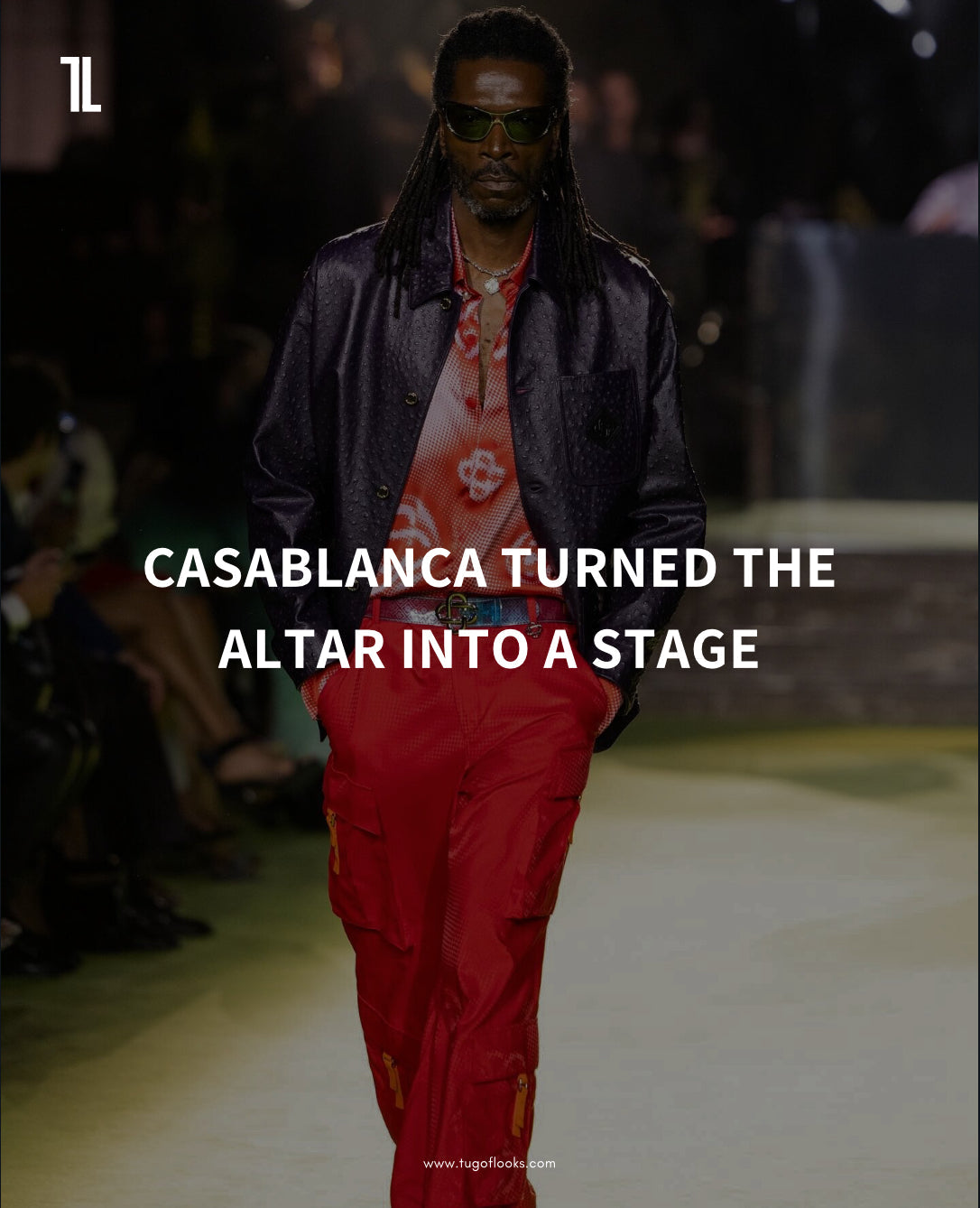
Casablanca’s Church Show and the Sermon of Style
Walking into a cathedral, you expect stained glass, silence, maybe the echo of a hymn. You don’t expect pounding house music, or models in lacquered tailoring and sportswear silhouettes striding past the pews. But that’s exactly the dissonance Casablanca chose for its most recent show: a runway staged inside a church, where the altar became a stage and worship became performance.
This wasn’t fashion-as-usual. It was a cultural sermon.
The Sacred Collides with the Secular
Casablanca has always had a knack for atmosphere, but this show went further. To use a church as runway is to invite tension: the sacred colliding with the secular, the solemn infused with the spectacular.

The venue — a towering Parisian cathedral — carried all the weight of history, ritual, and reverence. But instead of incense and liturgy, the air shook with rhythm. House music reverberated off stone arches, transforming the acoustics of worship into the cadence of nightlife.
Casablanca was asking us: What does it mean to gather? What does it mean to participate in ritual? Whether in church or on the dance floor, there is a shared pulse, a collective rhythm.
Fashion as Communion
The show’s imagery spoke in layers. A gospel choir sang live, their voices threading through the music like liturgical call-and-response. Models moved down the aisle in fluid tailoring, technical sportswear, and bold color palettes — garments that felt alive, made for motion.
“Choir, catwalks & culture woven into one,” read the headline from the visuals. It wasn’t just poetic copy. It was the reality of the space: the runway felt less like a transaction of style and more like an act of communion.
Difference here was not loud rebellion, but sacred reimagining. Casablanca reminded us that difference can be reverent, that pushing boundaries can sometimes mean drawing on ritual rather than rejecting it.
A Collection in Motion
At the heart of it all were the clothes and they carried the spirit of the room.
• Fluid tailoring met sportswear energy, blending structure and ease in a way that echoed both ceremony and dance.
• Colors pulsed in gradients and prints, reminiscent of strobe lights, club flyers, and glitch art; the aesthetic vocabulary of nightlife repurposed for high fashion.
• Accessories twisted the familiar into the unexpected: a sneaker became a heel, blurring athletic and elegant codes.
• Fabric shimmered with movement, garments designed not to hang still but to live in rhythm with the body.

This was not quiet luxury, nor was it shock for shock’s sake. It was a dialogue between stillness and movement, reverence and release.
The Runway as Ritual
Fashion shows have always borrowed from ritual. The procession of models, the silence before the music drops, the collective gaze of the audience all echo religious ceremony. Casablanca leaned into that truth and amplified it.


In the church, the runway became a liturgy of fabric and form. The garments weren’t just presented; they were preached. The choir wasn’t background sound; it was testimony. The altar wasn’t desecrated; it was reimagined as a stage where identity, community, and culture could collide.
Casablanca turned the show into a reminder: fashion is not only about clothes on bodies. It is about what happens when we gather around them — what we choose to celebrate, to worship, to elevate.
Why It Matters
In an age where fashion often feels flattened by algorithms, spectacle for spectacle’s sake can quickly lose meaning. Casablanca’s show cut through that by reclaiming weight. The choice of venue demanded reflection.
• On community: Church and club alike are places of congregation. Both are about belonging, about shared rhythm, about surrendering to something bigger than yourself.
• On ritual: Fashion can be a ritual, just as much as prayer. The act of dressing, of presenting, of watching, is its own ceremony.
• On culture: To stage a show here was not just an aesthetic decision, but a cultural one. It reframed the runway as more than commerce. It made it sermon, myth, memory.
The Legacy of the Show
This will be remembered not as just another seasonal presentation, but as a turning point in Casablanca’s narrative. Years from now, people will recall the church, the choir, the pulsing beats, the garments glowing under stained glass.

Casablanca dared to differ, and in doing so, reminded us that the runway can be more than spectacle. It can be culture. It can be ritual. It can be worship.
Closing Reflection
At Tug Of Looks, we believe in fashion as world-building. Casablanca’s church show is proof that a runway can expand worlds. It doesn’t just display garments, it redefines how we think about space, ritual, and belonging.
And maybe that is the true message: the altar and the stage are not opposites. They are mirrors. Both ask us to look, to listen, to believe.
📸 Images via Casablanca / Paris Fashion Week
📝 Journal Entry curated by Tug Of Looks